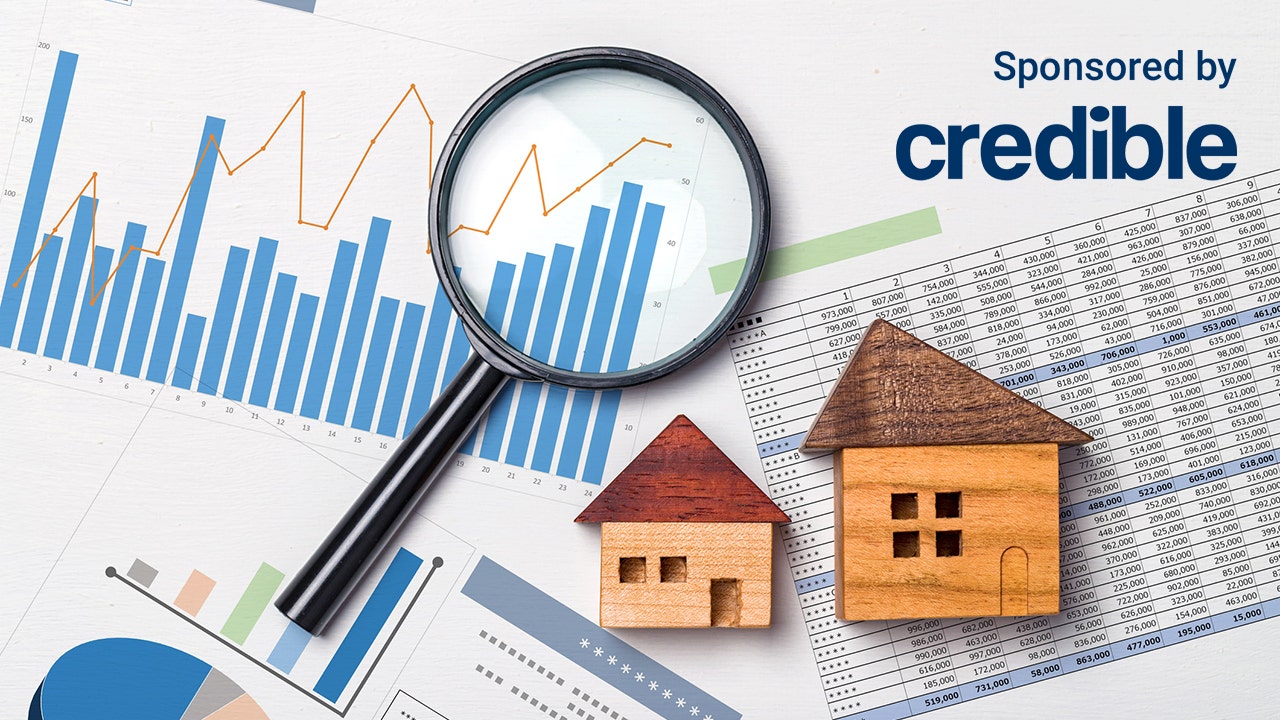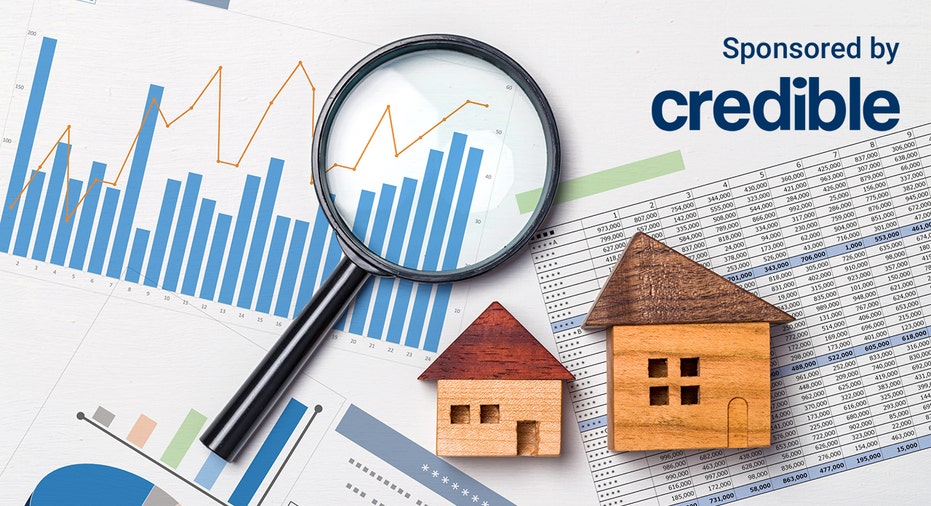Finance
Today’s 15- and 30-year mortgage rates hold steady | April 1, 2024
Published
1 year agoon

Our goal here at Credible Operations, Inc., NMLS Number 1681276, referred to as “Credible” below, is to give you the tools and confidence you need to improve your finances. Although we do promote products from our partner lenders who compensate us for our services, all opinions are our own.

Mortgage rates fluctuate almost daily based on economic conditions. Here are today’s mortgage rates and what you need to know about getting the best rate. (iStock)
The interest rate on a 30-year fixed-rate mortgage is 7.000% as of April 1, which is unchanged from Friday. Additionally, the interest rate on a 15-year fixed-rate mortgage is 6.000%, which is also unchanged from Friday.
With mortgage rates changing daily, it’s a good idea to check today’s rate before applying for a loan. It’s also important to compare different lenders’ current interest rates, terms, and fees to ensure you get the best deal.
Rates last updated on April 1, 2024. Rates are based on the assumptions shown here. Actual rates may vary. Credible, a personal finance marketplace, has 5,000 Trustpilot reviews with an average star rating of 4.7 (out of a possible 5.0).
How do mortgage rates work?
When you take out a mortgage loan to purchase a home, you’re borrowing money from a lender. In order for that lender to make a profit and reduce risk to itself, it will charge interest on the principal — that is, the amount you borrowed.
Expressed as a percentage, a mortgage interest rate is essentially the cost of borrowing money. It can vary based on several factors, such as your credit score, debt-to-income ratio (DTI), down payment, loan amount, and repayment term.
After getting a mortgage, you’ll typically receive an amortization schedule, which shows your payment schedule over the life of the loan. It also indicates how much of each payment goes toward the principal balance versus the interest.
Near the beginning of the loan term, you’ll spend more money on interest and less on the principal balance. As you approach the end of the repayment term, you’ll pay more toward the principal and less toward interest.
Your mortgage interest rate can be either fixed or adjustable. With a fixed-rate mortgage, the rate will be consistent for the duration of the loan. With an adjustable-rate mortgage (ARM), the interest rate can fluctuate with the market.
Keep in mind that a mortgage’s interest rate is not the same as its annual percentage rate (APR). This is because an APR includes both the interest rate and any other lender fees or charges.
Mortgage rates change frequently — sometimes on a daily basis. Inflation plays a significant role in these fluctuations. Interest rates tend to rise in periods of high inflation, whereas they tend to drop or remain roughly the same in times of low inflation. Other factors, like the economic climate, demand, and inventory can also impact the current average mortgage rates.
To find great mortgage rates, start by using Credible’s secured website, which can show you current mortgage rates from multiple lenders without affecting your credit score. You can also use Credible’s mortgage calculator to estimate your monthly mortgage payments.
What determines the mortgage rate?
Mortgage lenders typically determine the interest rate on a case-by-case basis. Generally, they reserve the lowest rates for low-risk borrowers — that is, those with a higher credit score, income, and down payment amount. Here are some other personal factors that may determine your mortgage rate:
- Location of the home
- Price of the home
- Your credit score and credit history
- Loan term
- Loan type (e.g., conventional or FHA)
- Interest rate type (fixed or adjustable)
- Down payment amount
- Loan-to-value (LTV) ratio
- DTI
Other indirect factors that may determine the mortgage rate include:
- Current economic conditions
- Rate of inflation
- Market conditions
- Housing construction supply, demand, and costs
- Consumer spending
- Stock market
- 10-year Treasury yields
- Federal Reserve policies
- Current employment rate
How to compare mortgage rates
Along with certain economic and personal factors, the lender you choose can also affect your mortgage rate. Some lenders have higher average mortgage rates than others, regardless of your credit or financial situation. That’s why it’s important to compare lenders and loan offers.
Here are some of the best ways to compare mortgage rates and ensure you get the best one:
- Shop around for lenders: Compare several lenders to find the best rates and lowest fees. Even if the rate is only lower by a few basis points, it could still save you thousands of dollars over the life of the loan.
- Get several loan estimates: A loan estimate comes with a more personalized rate and fees based on factors like income, employment, and the property’s location. Review and compare loan estimates from several lenders.
- Get pre-approved for a mortgage: Pre-approval doesn’t guarantee you’ll get a loan, but it can give you a better idea of what you qualify for and at what interest rate. You’ll need to complete an application and undergo a hard credit check.
- Consider a mortgage rate lock: A mortgage rate lock lets you lock in the current mortgage rate for a certain amount of time — often between 30 and 90 days. During this time, you can continue shopping around for a home without worrying about the rate changing.
- Choose between an adjustable- and fixed-rate mortgage: The interest rate type can affect how much you pay over time, so consider your options carefully.
One other way to compare mortgage rates is with a mortgage calculator. Use a calculator to determine your monthly payment amount and the total cost of the loan. Just remember, certain fees like homeowners insurance or taxes might not be included in the calculations.
Here’s a simple example of what a 15-year fixed-rate mortgage might look like versus a 30-year fixed-rate mortgage:
15-year fixed-rate
- Loan amount: $300,000
- Interest rate: 6.29%
- Monthly payment: $2,579
- Total interest charges: $164,186
- Total loan amount: $464,186
30-year fixed-rate
- Loan amount: $300,000
- Interest rate: 6.89%
- Monthly payment: $1,974
- Total interest charges: $410,566
- Total loan amount: $710,565
Pros and cons of mortgages
If you’re thinking about taking out a mortgage, here are some benefits to consider:
- Predictable monthly payments: Fixed-rate mortgage loans come with a set interest rate that doesn’t change over the life of the loan. This means more consistent monthly payments.
- Potentially low interest rates: With good credit and a high down payment, you could get a competitive interest rate. Adjustable-rate mortgages may also come with a lower initial interest rate than fixed-rate loans.
- Tax benefits: Having a mortgage could make you eligible for certain tax benefits, such as a mortgage interest deduction.
- Potential asset: Real estate is often considered an asset. As you pay down your loan, you can also build home equity, which you can use for other things like debt consolidation or home improvement projects.
- Credit score boost: With on-time payments, you can build your credit score.
And here are some of the biggest downsides of getting a mortgage:
- Expensive fees and interest: You could end up paying thousands of dollars in interest and other fees over the life of the loan. You will also be responsible for maintenance, property taxes, and homeowners insurance.
- Long-term debt: Taking out a mortgage is a major financial commitment. Typical loan terms are 10, 15, 20, and 30 years.
- Potential rate changes: If you get an adjustable rate, the interest rate could increase.
How to qualify for a mortgage
Requirements vary by lender, but here are the typical steps to qualify for a mortgage:
- Have steady employment and income: You’ll need to provide proof of income when applying for a home loan. This may include money from your regular job, alimony, military benefits, commissions, or Social Security payments. You may also need to provide proof of at least two years’ worth of employment at your current company.
- Review any assets: Lenders consider your assets when deciding whether to lend you money. Common assets include money in your bank account or investment accounts.
- Know your DTI: Your DTI is the percentage of your gross monthly income that goes toward your monthly debts — like installment loans, lines of credit, or rent. The lower your DTI, the better your approval odds.
- Check your credit score: To get the best mortgage rate possible, you’ll need to have good credit. However, each loan type has a different credit score requirement. For example, you’ll need a credit score of 580 or higher to qualify for an FHA loan with a 3.5% down payment.
- Know the property type: During the loan application process, you may need to specify whether the home you want to buy is your primary residence. Lenders often view a primary residence as less risky, so they may have more lenient requirements than if you were to get a secondary or investment property.
- Choose the loan type: Many types of mortgage loans exist, including conventional loans, VA loans, USDA loans, FHA loans, and jumbo loans. Consider your options and pick the best one for your needs.
- Prepare for upfront and closing costs: Depending on the loan type, you may need to make a down payment. The exact amount depends on the loan type and lender. A USDA loan, for example, has no minimum down payment requirement for eligible buyers. With a conventional loan, you’ll need to put down 20% to avoid private mortgage insurance (PMI). You may also be responsible for paying any closing costs when signing for the loan.
How to apply for a mortgage
Here are the basic steps to apply for a mortgage, and what you can typically expect during the process:
- Choose a lender: Compare several lenders to see the types of loans they offer, their average mortgage rates, repayment terms, and fees. Also, check if they offer any down payment assistance programs or closing cost credits.
- Get pre-approved: Complete the pre-approval process to boost your chances of getting your dream home. You’ll need identifying documents, as well as documents verifying your employment, income, assets, and debts.
- Submit a formal application: Complete your chosen lender’s application process — either in person or online — and upload any required documents.
- Wait for the lender to process your loan: It can take some time for the lender to review your application and make a decision. In some cases, they may request additional information about your finances, assets, or liabilities. Provide this information as soon as possible to prevent delays.
- Complete the closing process: If approved for a loan, you’ll receive a closing disclosure with information about the loan and any closing costs. Review it, pay the down payment and closing costs, and sign the final loan documents. Some lenders have an online closing process, while others require you to go in person. If you are not approved, you can talk to your lender to get more information and determine how you can remedy any issues.
How to refinance a mortgage
Refinancing your mortgage lets you trade your current loan for a new one. It does not mean taking out a second loan. You will also still be responsible for making payments on the refinanced loan.
You might want to refinance your mortgage if you:
- Want a lower interest rate or different rate type
- Are looking for a shorter repayment term so you can pay off the loan sooner
- Need a smaller monthly payment
- Want to remove the PMI from your loan
- Need to use the equity for things like home improvement or debt consolidation (cash-out refinancing)
The refinancing process is similar to the process you follow for the original loan. Here are the basic steps:
- Choose the type of refinancing you want.
- Compare lenders for the best rates.
- Complete the application process.
- Wait for the lender to review your application.
- Provide supporting documentation (if requested).
- Complete the home appraisal.
- Proceed to closing, review the loan documents, and pay any closing costs.
How to access your home’s equity
If you need to tap into your home’s equity to pay off debt, fund a renovation, or cover an emergency expense, there are two popular options to choose from: a home equity loan and a home equity line of credit (HELOC). Both a home equity loan and a HELOC allow you to borrow against your home’s equity but a home equity loan comes in the form of a lump sum payment and a HELOC is a revolving line of credit.
These two loan types have some other key similarities and differences in how they work:
| Home equity loan | Home equity line of credit (HELOC) | |
| Interest rate | Fixed | Variable |
| Monthly payment amount | Fixed | Variable |
| Closing costs and fees | Yes | Yes, might be lower than other loan types |
| Repayment period | Typically 5-30 years | Typically 10-20 years |
FAQ
What is a rate lock?
Interest rates on mortgages fluctuate all the time, but a rate lock allows you to lock in your current rate for a set amount of time. This ensures you get the rate you want as you complete the homebuying process.
What are mortgage points?
Mortgage points are a type of prepaid interest that you can pay upfront — often as part of your closing costs — for a lower overall interest rate. This can lower your APR and monthly payments.
What are closing costs?
Closing costs are the fees you, as the buyer, need to pay before getting a loan. Common fees include attorney fees, home appraisal fees, origination fees, and application fees.
If you’re trying to find the right mortgage rate, consider using Credible. You can use Credible’s free online tool to easily compare multiple lenders and see prequalified rates in just a few minutes.
You may like
Finance
New ETF gives investor chance to act like a private equity giant
Published
54 minutes agoon
June 15, 2025

The S&P 500 is less than 3% from an all-time high. Six of its 11 sectors are within 5% of an all-time high. But even as the U.S. stock market index proves its resilience during a volatile stretch for investors, more money from within portfolios is expected to shift in to privately traded companies.
Jan Van Eck, CEO of ETF and mutual fund manager VanEck, says the trend of companies staying private for longer rather than seeking an initial public offering is here to stay and it offers new opportunities.
High-profile examples include Elon Musk’s SpaceX, Sam Altman’s OpenAI and fintech Stripe.
According to Van Eck, allocations to private assets will jump from a current average portfolio holding level of approximately 2% to 10% in the years ahead.
Some ETFs have begun to invest small portions of their assets in privately held company shares, including SpaceX, such as the ERShares Private-Public Crossover ETF (XOVR). VanEck has launched an ETF tackling the private opportunity in a different way: taking big positions in the publicly traded shares of the investment giants, including private equity firms and other alternative asset managers, that own many private companies.
The VanEck Alternative Asset Manager ETF (GPZ), which launched this month, has a portfolio holdings list that includes Brookfield, Blackstone, KKR, Brookfield Asset Management and Apollo, which combined make up almost 50% of the fund. TPG, Ares and Carlyle are also big positions, in the 5% range each.
The new ETF extends an existing focus on private markets for VanEck. For over a decade, it has offered investors access to private credit, through the VanEck BDC Income ETF (BIZD), which invests in the business development companies that lend to small- and mid-sized private companies. That ETF has a high level of exposure to Ares, Blue Owl, Blackstone, Main Street and Golub Capital, which make up about half of the fund. It pays a hefty dividend of 11%.

Investing private through a publicly traded ETF
“You have to believe this is a secular trend and growth will be higher than that for normal money managers, including ETF and mutual fund managers,” said Van Eck.
He cautions, however, there is more volatility in these funds compared to the public equity market overall. “You have to size it appropriately,” he added.
Finance
China’s personal delivery market is growing. Only some are making money
Published
3 hours agoon
June 15, 2025
China’s large labor force and internet ecosystem have supported fleets of couriers delivering an increasing range of products on demand. U.S.-listed BingEx has taken a unique strategy by dedicating one delivery person for each order, becoming “a pioneer in the dedicated courier service industry,” Deutsche Bank analyst Jessie Xu said in a June 10 report that initiated coverage on the stock with a buy rating. By using the Chinese company’s app, someone in China can have their suitcase transported across town, or have the courier buy a specific cake and deliver it to a party. The business operates under the brand “FlashEx” or “Shan Song,” which means “delivery in a flash” in Mandarin. The brand’s name has become a local way to describe the service, just like Kleenex. FlashEx “started recording positive unit operating profit from 3Q23 and has been profitable since then,” Deutsche Bank’s Xu said, pointing out that most of its competitors still operate at a loss in the one-on-one courier business. On-demand delivery has become a competitive market that logistics companies and e-commerce platforms have expanded into, often with heavy subsidies and piling several orders onto one courier. But even Alibaba expects consumers will want to buy on demand, and in the last several weeks has rolled out a channel for people to buy food, clothes and other products on e-commerce platform Taobao — and get it delivered in as quickly as 30 minutes. Most of FlashEx’s competitors are subsidiaries of larger companies with other business lines. U.S.-listed Dada , which was previously a Walmart-backed supermarket delivery business separate from JD.com, was absorbed into the Chinese e-commerce giant over the last few years. Dada reported loss from operations rose to 2.16 billion yuan in 2024, up from 2.11 billion yuan a year earlier. Earlier this year, JD.com launched a campaign in on-demand delivery to compete with food delivery giant Meituan. Both companies reported operating losses for “new” initiatives in the first quarter. Chinese logistics giant SF Holdings has a small intra-city on-demand delivery unit, which contributed to just over 3% of total revenue last year. The segment’s revenue rose by 22% from a year ago, while its net profit more than doubled to 132 million yuan . The on-demand delivery market is expected to grow by an average of 13% a year through 2028, a slowdown from 20% annual growth from 2019 to 2023, Xu said in the report. “This growth should be supported by the rapid expansion of Online-to-Offline (O2O) retail, food delivery services, and increasing demand for personalized delivery options.” But personal, one-on-one courier services still represents only 4% to 5% of that delivery market, Xu said, predicting 10% annual growth in the next three years. She pointed out that as of the end of 2024, FlashEx had 2.8 million riders serving over 100 million registered customers in 295 cities. U.S.-traded shares of BingEx closed at $3.87 a piece on Friday, for 21% upside to Deutsche Bank’s price target of $4.70. However, the stock has plunged more than 50% so far this year after the company grappled with more competition and tepid Chinese consumer spending in the last several months. “FlashEx has strategically exited some 2B businesses since 2H24, as the company is focused more on” unit economics,” Xu said. “Management made it clear that the company will not chase pure volume market share gains at the cost of profitability. … This set a positive tone for the company’s sustainable growth and profitability in the mid-to-long run.” — CNBC’s Michael Bloom contributed to this report.
Finance
Israel-Iran attacks and the 2 other things that drove the stock market this week
Published
23 hours agoon
June 14, 2025
What was shaping up to be a relatively calm week quickly got volatile on Friday, following Israel’s overnight strike on Iran. Here is a closer look at the three biggest themes that defined the market this week. 1. Geopolitics: The attack on Iranian nuclear infrastructure rippled through financial markets on Friday. U.S. stocks sold off on the increased tensions overseas. The S & P 500 and Nasdaq Composite tumbled 1.13% and 1.3% on Friday, respectively. Meanwhile, Brent crude futures and West Texas Intermediate crude futures added around 7% and 7.5%, respectively. Gold rose to a two-month high, as well, as investors see it as a safe haven from all the volatility. Prior to the attack, stock benchmark were on track to close the week in the positive. Instead, the S & P 500 and Nasdaq lost 0.4% and 0.6% over that stretch, snapping back-to-back weekly wining streaks. Despite a modest gain Friday, part of the safe-haven trade, the U.S. dollar index had a tough week. On Thursday, we wrote about how long-term fundamental investors should view the weaker dollar. Another big geopolitical event for investors was an announcement by U.S. and Chinese delegations that the two sides agreed on a trade-deal framework, particularly focused on rare-earth minerals. 2. Economic data: Investors received good news on the inflation front on Wednesday and Thursday. On Wednesday, the c onsumer price index, a measure of goods and services inflation across the U.S. economy, showed that core prices rose less that expected last month. The May producer price index , a gauge of wholesale inflation in the country, came in lower than expected Thursday, too. The labor market continued to show it was softening but not breaking. Weekly jobless claims for the week ending June 7 were unchanged, while continuing claims were still at multiyear highs. On the whole, the batch of economic data was encouraging as the rate of inflation subsides and unemployment remains low, providing the consumer with more buying power. 3. AI updates: It was also a week chock full of company specific news and events within the generative artificial intelligence race. AI remains one of the most important, if not the most important, drivers for financial markets. On Monday, we heard from Apple, when the company hosted its annual worldwide developer conference. Though expectations were about as muted as we’ve ever seen, the event still managed to disappoint due to the lack of AI updates. Meta Platforms, on the other hand, got investors excited this week when news broke that the company took a large investment in Scale AI and will bring the startup’s CEO on board to help start a new “superintelligence” unit within the company with the goal of achieving artificial general intelligence. Early Wednesday morning, we heard from Nvidia CEO Jensen Huang, who spoke at the company’s GTC event in Paris. While there weren’t many new updates, Huang reaffirmed that there is still a lot more accelerated compute capacity that needs to be built out, highlighting demand from hyperscale customers and sovereign entities alike. Europe, he argued, is likely to 10 times its compute capacity over the next two years. Outside the portfolio, Oracle and Advanced Micro Devices made news on AI, too. Oracle stock jumped Thursday after reporting better-than-expected quarterly results the prior evening. Impressively, the stock soared again Friday, despite the broader market sell-off, en route to its best week since 2021 . BMO Capital also upgraded Oracle to a buy rating. Oracle CEO Safra Catz’s comments on its cloud infrastructure business confirmed that there’s growing demand for AI computing power. Indeed, Oracle said revenues from that business should surge 70% year over year in its fiscal 2026. Elsewhere, Advanced Micro Devices unveiled its new AI server chip for 2026 at a company event Thursday, part of its attempt to rival Nvidia’s market-leading offering. AMD also announced that it’s landed a new high-profile customer OpenAI, the startup behind ChatGPT and Club holding Microsoft’s AI partner. The chip isn’t expected to launch until 2026, though. (Jim Cramer’s Charitable Trust is long AAPL, META, NVDA. See here for a full list of the stocks.) As a subscriber to the CNBC Investing Club with Jim Cramer, you will receive a trade alert before Jim makes a trade. Jim waits 45 minutes after sending a trade alert before buying or selling a stock in his charitable trust’s portfolio. If Jim has talked about a stock on CNBC TV, he waits 72 hours after issuing the trade alert before executing the trade. THE ABOVE INVESTING CLUB INFORMATION IS SUBJECT TO OUR TERMS AND CONDITIONS AND PRIVACY POLICY , TOGETHER WITH OUR DISCLAIMER . NO FIDUCIARY OBLIGATION OR DUTY EXISTS, OR IS CREATED, BY VIRTUE OF YOUR RECEIPT OF ANY INFORMATION PROVIDED IN CONNECTION WITH THE INVESTING CLUB. NO SPECIFIC OUTCOME OR PROFIT IS GUARANTEED.

New ETF gives investor chance to act like a private equity giant

China’s personal delivery market is growing. Only some are making money

Protests against a regal presidency have been notably peaceful

New 2023 K-1 instructions stir the CAMT pot for partnerships and corporations

The Essential Practice of Bank and Credit Card Statement Reconciliation

Are American progressives making themselves sad?
Trending
-

 Economics1 week ago
Economics1 week agoJobs report May 2025:
-

 Economics1 week ago
Economics1 week agoDonald Trump has many ways to hurt Elon Musk
-

 Economics1 week ago
Economics1 week agoSending the National Guard to LA is not about stopping rioting
-

 Finance1 week ago
Finance1 week agoStocks making the biggest moves midday: WOOF, TSLA, CRCL, LULU
-

 Blog Post1 week ago
Blog Post1 week agoMastering Bookkeeping Tasks During Peak Business Seasons
-

 Economics1 week ago
Economics1 week agoDonald Trump has many ways to hurt Elon Musk
-

 Personal Finance1 week ago
Personal Finance1 week agoWhat Pell Grant changes in Trump budget, House tax bill mean for students
-

 Economics1 week ago
Economics1 week agoRussia cuts sky-high interest rates for the first time since 2022
